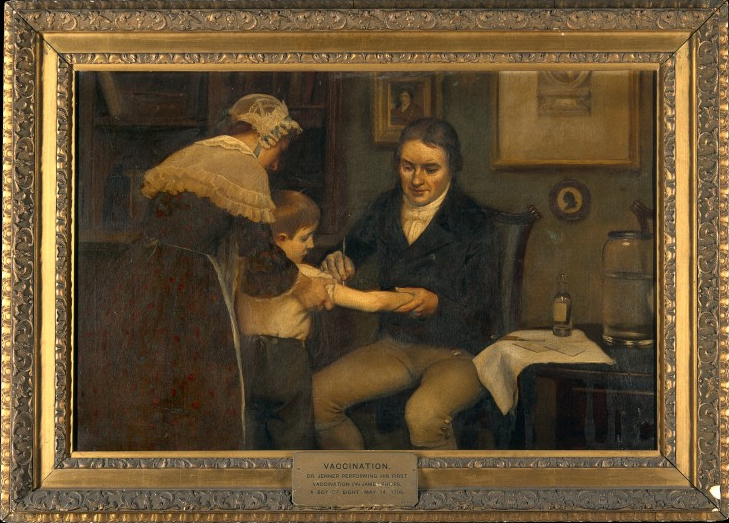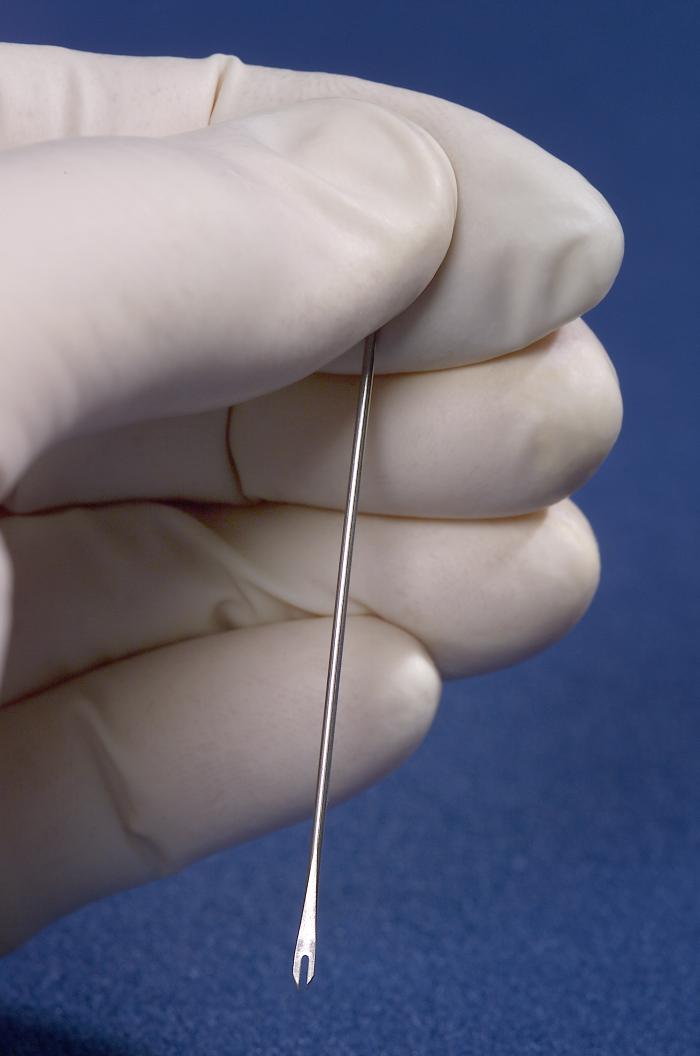|
Smallpox Vaccine
The smallpox vaccine is the first vaccine to be developed against a contagious disease. In 1796, British physician Edward Jenner demonstrated that an infection with the relatively mild cowpox virus conferred immunity against the deadly smallpox virus. Cowpox served as a natural vaccine until the modern smallpox vaccine emerged in the 20th century. From 1958 to 1977, the World Health Organization (WHO) conducted a global vaccination campaign that eradicated smallpox, making it the only human disease to be eradicated. Although routine smallpox vaccination is no longer performed on the general public, the vaccine is still being produced to guard against bioterrorism, biological warfare, and monkeypox.Anderson MG, Frenkel LD, Homann S, and Guffey J. (2003), "A case of severe monkeypox virus disease in an American child: emerging infections and changing professional values"; ''Pediatr Infect Dis J'';22(12): 1093–96; discussion 1096–98. The term ''vaccine'' derives from the Lati ... [...More Info...] [...Related Items...] OR: [Wikipedia] [Google] [Baidu] |
Diluent
A diluent (also referred to as a filler, dilutant or thinner) is a diluting agent. Certain fluids are too viscous to be pumped easily or too dense to flow from one particular point to the other. This can be problematic, because it might not be economically feasible to transport such fluids in this state. To ease this restricted movement, diluents are added. This decreases the viscosity of the fluids, thereby also decreasing the pumping/transportation costs. One industrial application is the transport of crude oil via pipelines. Heavy crude oil/bitumen are fluids with high viscosity, especially at low temperatures. The addition of a diluent enables the diluted fluid (dilbit in the case of bitumen) to meet pipeline specifications in order for it to be efficiently transported. Typical diluent in this case is naphtha or condensate. Types of diluents more familiar to the general public include paint thinner and nail polish thinner, both of which improve the consistency and applica ... [...More Info...] [...Related Items...] OR: [Wikipedia] [Google] [Baidu] |
Horsepox
''Orthopoxvirus'' is a genus of viruses in the family ''Poxviridae'' and subfamily ''Chordopoxvirinae''. Vertebrates, including mammals and humans, and arthropods serve as natural hosts. There are 12 species in this genus. Diseases associated with this genus include smallpox, cowpox, horsepox, camelpox, and monkeypox. The most widely known member of the genus is '' Variola virus'', which causes smallpox. It was eradicated globally by 1977, through the use of ''Vaccinia virus'' as a vaccine. The most recently described species is the '' Alaskapox virus'', first isolated in 2015. Microbiology Structure Orthopoxviruses are enveloped with brick-shaped geometries and virion dimensions around 200 nm wide and 250 nm long. Genome Member viruses have linear DNA genomes around 170–250 kb in length. Lifecycle Viral replication is cytoplasmic. Entry into the host cell is achieved by attachment of the viral proteins to host glycosaminoglycans (GAGs), which mediate cellul ... [...More Info...] [...Related Items...] OR: [Wikipedia] [Google] [Baidu] |
Baxter International
Baxter International Inc. is an American multinational healthcare company with headquarters in Deerfield, Illinois. The company primarily focuses on products to treat kidney disease, and other chronic and acute medical conditions. The company had 2017 sales of $10.6 billion, across two businesses: BioScience and Medical Products. Baxter's BioScience business produces recombinant and blood plasma proteins to treat hemophilia and other bleeding disorders; plasma-based therapies to treat immune deficiencies and other chronic and acute blood-related conditions; products for regenerative medicine, and vaccines. Baxter's Medical Products business produces intravenous products and other products used in the delivery of fluids and drugs to patients; inhalational anaesthetics; contract manufacturing services; and products to treat end-stage kidney disease, or irreversible kidney failure, including products for peritoneal dialysis and hemodialysis. History Baxter International was ... [...More Info...] [...Related Items...] OR: [Wikipedia] [Google] [Baidu] |
Vero Cell
Vero cells are a lineage of cells used in cell cultures. The 'Vero' lineage was isolated from kidney epithelial cells extracted from an African green monkey (''Chlorocebus'' sp.; formerly called ''Cercopithecus aethiops'', this group of monkeys has been split into several different species). The lineage was developed on 27 March 1962, by Yasumura and Kawakita at the Chiba University in Chiba, Japan. The original cell line was named '' Vero'' after an abbreviation of , which means 'green kidney' in Esperanto, while itself means 'truth' in Esperanto. Characteristics The Vero cell lineage is continuous and aneuploid, meaning that it has an abnormal number of chromosomes. A continuous cell lineage can be replicated through many cycles of division and not become senescent. Vero cells are interferon-deficient; unlike normal mammalian cells, they do not secrete interferon alpha or beta when infected by viruses. However, they still have the Interferon-alpha/beta receptor, so they res ... [...More Info...] [...Related Items...] OR: [Wikipedia] [Google] [Baidu] |
MRC-5
MRC-5 ( Medical Research Council cell strain 5) is a diploid cell culture line composed of fibroblasts, originally developed from the lung tissue of a 14-week-old aborted Caucasian male fetus. The cell line was isolated by J.P. Jacobs and colleagues in September 1966 from the seventh population doubling of the original strain, and MRC-5 cells themselves are known to reach senescence in around 45 population doublings. Applications MRC-5 cells are currently used to produce several vaccines including for hepatitis A, varicella and polio. Culture and society During the COVID-19 pandemic, anti-vaccination and anti-abortion activists believed that MRC-5 was an ingredient of the Oxford–AstraZeneca COVID-19 vaccine, citing a study from the University of Bristol. David Matthews, a co-author for this study, clarified that MRC-5 was solely used for testing purposes to determine "how the Oxford vaccine behaves when it is inside a genetically normal human cell." The manufacturing of the v ... [...More Info...] [...Related Items...] OR: [Wikipedia] [Google] [Baidu] |
ACAM2000
ACAM2000 is a smallpox vaccine manufactured by Sanofi Pasteur Biologics Co. The vaccine provides protection against smallpox for people determined to be at high risk for smallpox infection. Background Smallpox is considered a biological threat. Biological agents are toxins or organisms that can cause illness or death in humans, animals and plants. Exposure can come from an intentional biological terrorist attack, accidental release of the agent, or a natural accident. Smallpox was eradicated in 1980. However, there has been interest in the development of vaccines due to the possible use of smallpox as a bioweapon. Smallpox vaccine development Smallpox vaccine development is now in its second generation. First-generation vaccines were derived from calf-lymph, and include Dryvax, APVS, Lancy-vaxina and Lister. Second-generation vaccines are cell-cultured and include ACAM2000 and CCSV. Both Dryvax and ACAM2000 come from the New York City Board of Health strain of vaccinia. D ... [...More Info...] [...Related Items...] OR: [Wikipedia] [Google] [Baidu] |
National Institute For Public Health And The Environment
The National Institute for Public Health and the Environment ( nl, Rijksinstituut voor Volksgezondheid en Milieu or simply RIVM) is a Dutch research institute that is an independent agency of the Ministry of Health, Welfare and Sport. RIVM performs tasks to promote public health and a safe living environment by conducting research and collecting knowledge worldwide. The results are used to support the Government of the Netherlands in formulating its policy. RIVM's primary tasks are: * research * policy support * national coordination * intervention programmes * provision of reliable information to the public and to professionals working in health care about infectious diseases, the environment, nutrition and safety. RIVM is located in Bilthoven, Utrecht and employs over 1,500 people, many of whom work in multidisciplinary fields. History RIVM was founded in 1910 when the Central Laboratory for Public Health was created. The present size of the institute is the result of a merge ... [...More Info...] [...Related Items...] OR: [Wikipedia] [Google] [Baidu] |
Thomas Milton Rivers
Thomas Milton Rivers (September 3, 1888 – May 12, 1962) was an American bacteriologist and virologist. He has been described as the "father of modern virology." Life Born in Jonesboro, Georgia, he graduated from Emory College in 1909 with a Bachelor of Arts degree. Immediately following graduation, Rivers was admitted to the Johns Hopkins Medical School. His plans of becoming a physician could not be realized at first as he was diagnosed with a neuromuscular degeneration which forced him to leave medical school and work as a laboratory assistant at a hospital in the Panama Canal Zone. When by 1912 the illness had not become worse he returned to Johns Hopkins and graduated in 1915. He stayed at Johns Hopkins until 1919. In March 1922 he headed the infectious disease ward at the Rockefeller Institute for Medical Research and became the institute's director in June 1937. After retiring in 1956, he remained active with the Rockefeller Foundation. His work in the 1930s and 1940s ... [...More Info...] [...Related Items...] OR: [Wikipedia] [Google] [Baidu] |
Avian Sarcoma Leukosis Virus
Avian sarcoma leukosis virus (ASLV) is an endogenous retrovirus that infects and can lead to cancer in chickens; experimentally it can infect other species of birds and mammals. ASLV replicates in chicken embryo fibroblasts, the cells that contribute to the formation of connective tissues. Different forms of the disease exist, including lymphoblastic, erythroblastic, and osteopetrotic. Avian sarcoma leukosis virus is characterized by a wide range of tumors, the most common of which are lymphomas. Lymphoid leukosis is the most common form of this disease and with typical presentation of gradual onset, persistent low mortality, and neoplasia of the bursa. The disease is also characterized by an enlarged liver due to infiltration of cancerous lymphoid cells. In addition, other abdominal organs and the bursa of Fabricius are often infected. Occurrence Lymphoid leukosis has a worldwide distribution, and is most commonly found in birds 16 weeks or older. History Sarcoma in chicken ... [...More Info...] [...Related Items...] OR: [Wikipedia] [Google] [Baidu] |
Alice Miles Woodruff
Alice Miles Woodruff (November 29, 1900 – November 24, 1985), born Alice Lincoln Miles, was an American virologist. She developed a method for growing fowlpox outside of a live chicken alongside Ernest William Goodpasture. Her research greatly facilitated the rapid advancement in the study of viruses. Early life and education Alice Lincoln Miles was born in Cambridge, Massachusetts, the daughter of Arthur L. Miles and Marie Augusta Putnam Miles. Her father was a dentist. She graduated from Mount Holyoke College in 1922. She obtained a master's degree in 1924 and a PhD in 1925 from Yale University. Career Woodruff worked as a research assistant at Vanderbilt University from 1927 until 1931. While working with her husband and Goodpasture, she conducted studies in the "nature, infectivity, and purification of fowl-pox virus, and the character of the changes it induced on experimental infection of fowls," which became the forerunner in the cultivation of viruses. Woodruff was ... [...More Info...] [...Related Items...] OR: [Wikipedia] [Google] [Baidu] |
Ernest William Goodpasture
Ernest William Goodpasture (October 17, 1886 – September 20, 1960) was an American pathologist and physician. Goodpasture advanced the scientific understanding of the pathogenesis of infectious diseases, parasitism, and a variety of rickettsial and viral infections. Together with colleagues at Vanderbilt University, he invented methods for growing viruses and rickettsiae in chicken embryos and fertilized chicken eggs. This enabled the development of vaccines against influenza, chicken pox, smallpox, yellow fever, typhus, Rocky mountain spotted fever, and other diseases. He also described Goodpasture syndrome.Valentini, Rudolph PPediatric Anti-GBM Disease (Goodpasture Syndrome). Accessed 8-28-2009. Education and professional career Goodpasture was born in Clarksville, Tennessee, in 1886. He received his B.A. from Vanderbilt University in 1908. In 1912, Goodpasture graduated from Johns Hopkins School of Medicine with an M.D. degree. There, under professors William H. Welch an ... [...More Info...] [...Related Items...] OR: [Wikipedia] [Google] [Baidu] |


.jpg)

